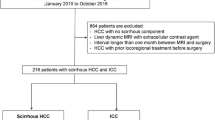Abstract
Background
The ultrasonography contrast agent Sonazoid provides parenchyma-specific contrast imaging (Kupffer imaging) based on its accumulation in Kupffer cells. This agent also facilitates imaging of the fine vascular architecture in tumors through maximum intensity projection (MIP). We examined the clinical utility of the malignancy grading system for hepatocellular carcinoma (HCC) using a combination of 2 different contrast-enhanced ultrasonography images.
Methods
We studied 121 histologically confirmed cases of HCC (well-differentiated, 45; moderately differentiated, 70; poorly differentiated, 6). The results of Kupffer imaging were classified as (1) iso-echoic pattern or (2) hypo-echoic pattern. The MIP patterns produced were classified into one of the following categories: fine, tumor vessels were not clearly visualized and only fine vessels were visualized; vascular, tumor vessels were visualized clearly; irregular, tumor vessels were thick and irregular. Based on the combined assessment of Kupffer imaging and the MIP pattern, the samples were classified into 4 grades: Grade 1 (iso-fine/vascular), Grade 2 (hypo-fine), Grade 3 (hypo-vascular), and Grade 4 (hypo-irregular).
Results
The distribution of moderately and poorly differentiated HCCs was as follows: Grade 1, 4 % (1/24); Grade 2, 52 % (15/29); Grade 3, 85 % (44/52); and Grade 4, 100 % (16/16). The grading system also predicted portal vein invasion in 72 resected HCCs: Grade 1, 0 % (0/4); Grade 2, 13 % (1/8); Grade 3, 23 % (11/48); and Grade 4, 67 % (8/12).
Conclusions
This new malignant grading system is useful for estimation of histological differentiation and portal vein invasion of HCC.






Similar content being viewed by others
References
El-Serag HB, Rudolph KL. Hepatocellular carcinoma: epidemiology and molecular carcinogenesis. Gastroenterology. 2007;132:2557–76.
Parkin DM, Bray F, Ferlay J, Pisani P. Global cancer statistics, 2002. CA Cancer J Clin. 2005;55:74–108.
Tamura S, Kato T, Berho M, Misiakos EP, O’Brien C, Reddy KR, et al. Impact of histological grade of hepatocellular carcinoma on the outcome of liver transplantation. Arch Surg. 2001;136:25–30 Discussion 31.
Kumada T, Nakano S, Takeda I, Sugiyama K, Osada T, Kiriyama S, et al. Patterns of recurrence after initial treatment in patients with small hepatocellular carcinoma. Hepatology. 1997;25:87–92.
Sakurai M, Okamura J, Seki K, Kuroda C. Needle tract implantation of hepatocellular carcinoma after percutaneous liver biopsy. Am J Surg Pathol. 1983;7:191–5.
Smith EH. Complications of percutaneous abdominal fine-needle biopsy. Review. Radiology. 1991;178:253–8.
Watanabe R, Matsumura M, Chen CJ, Kaneda Y, Ishihara M, Fujimaki M. Gray-scale liver enhancement with Sonazoid (NC100100), a novel ultrasound contrast agent; detection of hepatic tumors in a rabbit model. Biol Pharm Bull. 2003;26:1272–7.
Hagen EK, Forsberg F, Aksnes AK, Merton DA, Liu JB, Tornes A, et al. Enhanced detection of blood flow in the normal canine prostate using an ultrasound contrast agent. Invest Radiol. 2000;35:118–24.
Yao J, Teupe C, Takeuchi M, Avelar E, Sheahan M, Connolly R, et al. Quantitative 3-dimensional contrast echocardiographic determination of myocardial mass at risk and residual infarct mass after reperfusion: experimental canine studies with intravenous contrast agent NC100100. J Am Soc Echocardiogr. 2000;13:570–81.
Korenaga K, Korenaga M, Furukawa M, Yamasaki T, Sakaida I. Usefulness of Sonazoid contrast-enhanced ultrasonography for hepatocellular carcinoma: comparison with pathological diagnosis and superparamagnetic iron oxide magnetic resonance images. J Gastroenterol. 2009;44:733–41.
Imai Y, Murakami T, Yoshida S, Nishikawa M, Ohsawa M, Tokunaga K, et al. Superparamagnetic iron oxide-enhanced magnetic resonance images of hepatocellular carcinoma: correlation with histological grading. Hepatology. 2000;32:205–12.
Inoue T, Kudo M, Watai R, Pei Z, Kawasaki T, Minami Y, et al. Differential diagnosis of nodular lesions in cirrhotic liver by post-vascular phase contrast-enhanced US with Levovist: comparison with superparamagnetic iron oxide magnetic resonance images. J Gastroenterol. 2005;40:1139–47.
Wilson SR, Jang HJ, Kim TK, Iijima H, Kamiyama N, Burns PN. Real-time temporal maximum-intensity-projection imaging of hepatic lesions with contrast-enhanced sonography. Am J Roentgenol. 2008;190:691–5.
Sugimoto K, Moriyasu F, Kamiyama N, Metoki R, Yamada M, Imai Y, et al. Analysis of morphological vascular changes of hepatocellular carcinoma by microflow imaging using contrast-enhanced sonography. Hepatol Res. 2008;38:790–9.
Terminology of nodular hepatocellular lesions. International Working Party. Hepatology. 1995;22:983–93.
Hayashi M, Matsui O, Ueda K, Kawamori Y, Kadoya M, Yoshikawa J, et al. Correlation between the blood supply and grade of malignancy of hepatocellular nodules associated with liver cirrhosis: evaluation by CT during intraarterial injection of contrast medium. Am J Roentgenol. 1999;172:969–76.
Johnson CM, Sheedy PF, Stanson AW, Stephens DH, Hattery RR, Adson MA. Computed tomography and angiography of cavernous hemangiomas of the liver. Radiology. 1981;138:115–21.
Wen YL, Kudo M, Zheng RQ, Ding H, Zhou P, Minami Y, et al. Characterization of hepatic tumors: value of contrast-enhanced coded phase-inversion harmonic angio. Am J Roentgenol. 2004;182:1019–26.
Conflict of interest
Shuhei Nishiguchi received financial support from Chugai Pharmaceutical, MSD, Dainippon Sumitomo Pharma, Ajinomoto Pharma, and Otsuka Pharmaceutical. Hiroko Iijima received financial support from Chugai Pharmaceutical. Hiroyasu Imanishi received financial support from Chugai Pharmaceutical. The remaining authors have no conflict of interest.
Author information
Authors and Affiliations
Corresponding author
Additional information
H. Tanaka and H. Iijima contributed equally to this work.
Rights and permissions
About this article
Cite this article
Tanaka, H., Iijima, H., Higashiura, A. et al. New malignant grading system for hepatocellular carcinoma using the Sonazoid contrast agent for ultrasonography. J Gastroenterol 49, 755–763 (2014). https://doi.org/10.1007/s00535-013-0830-1
Received:
Accepted:
Published:
Issue Date:
DOI: https://doi.org/10.1007/s00535-013-0830-1




